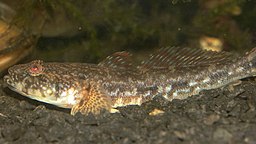 |
Bighead goby | Status LU: established. 1st record: ~2010 |
 |
Kessler-Grondel | Status Eur.: established. |
 |
Gobie de Kessler | RA: ISEIA: A2, Black List. Harmonia+: n/a. |
 |
Kessler-Grundel | Wikipedia: |
 |
Kesslers grondel | Back to the list of vertebrates |
Contents
Brief description
 Neogobius kessleri (Günther, 1861) is a fish that occurs in fresh and brackish water, in lower rivers and lagoons, on rocky bottoms or in reed thickets. It is native to the Black Sea.
Neogobius kessleri (Günther, 1861) is a fish that occurs in fresh and brackish water, in lower rivers and lagoons, on rocky bottoms or in reed thickets. It is native to the Black Sea.
Status and distribution in Luxembourg
Records of Neogobius kessleri (Günther, 1861) in Luxembourg. Data source: Recorder-Lux, iNaturalist & GBIF, 2025-06-13.
On 27th July 2015, a parliamentary question was raised in the Luxembourg Parliament about the invasion of Neogobius species in the Moselle river. This was echoed in the daily newspaper Tageblatt on the same day (Wildschutz 2015).
The distribution map is incomplete because records still have to be entered into the Recorder-Lux database (MNHNL, iNaturalist & GBIF 2019).
Risk assessment
ISEIA protocol
A2 (3+3+3+2) = Black List (Ries et al. 2014: 199).
Harmonia+ protocol
Not assessed yet.
Natural range and places of introduction in Europe

2014 by Yuriy Kvach. CC BY-SA 4.0, https://commons.wikimedia.org/w/index.php?curid=35161897 (Wikimedia Commons contributors 2020)
Worldwide distribution

GBIF 2019: https://www.gbif.org/species/2379062
Bibliography
-
- Dohet, A., 2017. Personal communication. LIST.
-
GBIF, 2019. Neogobius kessleri (Günther, 1861) in GBIF Secretariat (2019). GBIF Backbone Taxonomy. Checklist dataset https://doi.org/10.15468/39omei [accessed 2020-04-22]
- MNHNL, iNaturalist & GBIF, 2019. Neogobius kessleri (Günther, 1861) in MNHNL-mdata, online portal combining species observation from Recorder-Lux, iNaturalist and GBIF. National Museum of Natural History, Luxembourg. URL: https://mdata.mnhn.lu [Accessed 2019-10-24]
- Ries, C., M. Pfeiffenschneider, Engel, E., J.-C. Heidt & M. Lauff, 2014. Environmental impact assessment and black, watch and alert list classification after the ISEIA Protocol of vertebrates in Luxembourg. Bull. Soc. Nat. luxemb. 115: 195-201. [PDF 247 KB]
- Wildschutz, N., 2015. Grundel-Plage in der Mosel. Tageblatt online 27.07.2015. URL: http://www.tageblatt.lu/nachrichten/grundel-plage-in-der-mosel-16593303/ [2018.04.13]
- Wikimedia Commons contributors, 2020. ‘File:Bighead goby map.png’, Wikimedia Commons, the free media repository, 12 April 2020, 19:21 UTC, <https://commons.wikimedia.org/w/index.php?title=File:Bighead_goby_map.png&oldid=410862049> [accessed 2020-04-22]
Page content last updated on 2020-04-22. Last proofread by Caroline Grounds on 2019-11-27.



